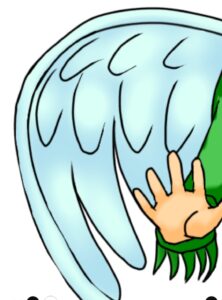Hello, this time I will explain how to add shadows to two-headed characters.
1. What are the basics of shadows?

Shadows are dark areas that appear in areas where light does not reach. When drawing two-headed characters, adding shadows well will add a three-dimensional look to the character and make the whole picture more attractive. Learning how to add shadows will make the character feel much more realistic.
2. Decide on the light source

Before drawing a shadow, it is important to first decide the position of the light source. The direction in which the shadow will be cast will depend on where the light source is.
First, consider the direction of the light and the st rength of the light source.
If the light is coming from above, the shadow will be cast downward. If the light is coming from the side, the shadow will be cast on the opposite side. Consider the direction of the light source and decide where to place the shadow.
Next, if the light is strong, the shadow will be clear and dark. Conversely, if the light is weak, the shadow will be soft. Be careful, the darkness of the shadow changes depending on the st rength of the light source.
3. Adding shadows to the face

Adding shadows to the face of a two-headed character will make the expression more expressive. In particular, drawing shadows under the hair and hat will give the face a three-dimensional look.
Shadows under the eyes, nose, and mouth. We will also explain the shadows on the hair.
First, if the light is coming from above, drawing a light shadow under the eyes will make the character look more realistic. Draw the shadow softly according to the size of the eyes.
Next, adding a little shadow under the nose and mouth will emphasize the three-dimensional look of the face. Especially when the character is smiling, using the shadow of the mouth effectively will highlight the character's expression.
Finally, draw a darker shadow in the areas where the hair falls on the face. This will make the hair look three-dimensional.
4. Adding shadows to the body and limbs

Next, add shadows to the character's body and limbs. This will give the character a more solid look.
Next, think about the direction of the shadows on the arms, legs, and clothes.
If the light is coming from above, draw shadows on the undersides of the arms and legs. Shadows look natural if they match the shape of the hands and feet.
Next, draw shadows on the parts of the clothes where wrinkles will form. Shadows are particularly likely to form around the bent arms and legs and around the waist. Adding shadows makes the texture of the clothes look more realistic.
Finally, adding soft shading to the entire body will increase the sense of three-dimensionality. Drawing dark shadows on parts of the body according to the direction of the light source will give the character more presence.
5. Finishing touches and adjusting shadows
Finally, finish the shadows while checking the overall balance. At this stage, make fine adjustments to make the shadows look natural.
Add shadow blur and reflected light to check the overall balance.
If the edges of the shadow are too hard, it may look unnatural. By blurring the shadow a little, you can create a softer impression.
Next, add a little reflected light to the parts where the shadow is too dark to create depth. This makes the whole character look more three-dimensional.
Finally, after drawing the shadow, look over the whole character to make sure it is balanced. If there are any unnatural parts, make corrections at this stage.
Summary of adding shadows to two-headed characters
Adding shadows to two-headed characters adds three-dimensionality and depth to the drawing. Adding shadows while keeping the light source in mind and creating natural shadows will make the character look lively. It may seem difficult at first, but with practice, you will improve your shadowing skills and add even more charm to your characters.